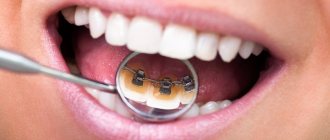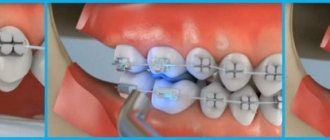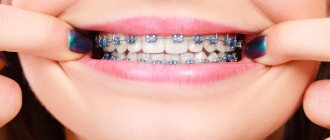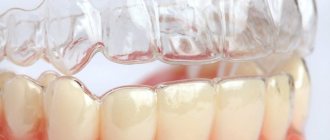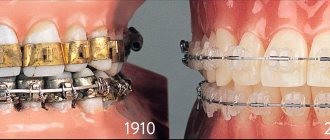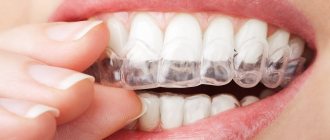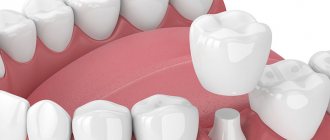Dental braces - what are they, what are they for, in what cases should they be installed? The design has gained enormous popularity over the past decades. Firstly, this treatment is effective; in a short period of time you can get straight teeth and enjoy a dazzling smile in the mirror. Secondly, there are many types of corrective elements to suit every taste and budget. Thirdly, it is possible to correct orthodontic problems at different ages. Even complex anomalies of the dentofacial apparatus can be corrected.
Let's consider what violations are eliminated in this way, how much time and money it will take.
Dental braces: what are they?
The design consists of brackets made of metal, ceramics or other materials. The system is attached to the outside or inside of the jaws. All elements are held on a special thin wire.
An orthodontic apparatus is necessary to eliminate pathologies that are associated with incorrect position of teeth. People mistakenly believe that the main purpose of such intervention is the aesthetic appeal of a smile. Doctors do not agree with this and argue that the curvature of incisors, canines and molars is primarily a medical problem, since it often leads to health problems. Food is not crushed enough when chewed, and then poorly digested, as a result of which diseases of the gastrointestinal tract develop.
There are other pathological processes that can only be dealt with with the help of staples. In some cases, extraction is required before installation.
Content
- The impact of malocclusion on health
- Making a choice
- Removable type of braces for adults
- Popular braces
- What is a retainer?
- Systems for teenagers
- For children
- Do your teeth hurt during treatment?
- How to care for your oral cavity?
- Pain after removal
A beautiful smile can work wonders.
People who regularly show their teeth are more successful in life than those who don't. But what to do if nature has not given you the opportunity to smile? The most common reason for this is uneven teeth. A person becomes unsure of himself and begins to communicate less with people. In a word, he develops an inferiority complex. But there is a solution to this problem. Medicine is developing rapidly, and now anyone can get dental braces. With their help you can correct your bite. Moreover, this can be done quite quickly. For example, advanced cases take five years - this is exactly the period required to straighten the teeth.
But not everyone decides to get braces. Why? The fact is that most people are subject to stereotypes. Malocclusion occurs in 70% of the world's population. And what part of them do you think undergo treatment with braces? Less than half! And all because they consider it ineffective and painful. But that's not true.
After all, modern orthodontics offers a huge variety of designs that have different effects on teeth and look different. People who are involved in public life are often concerned about aesthetic issues. This is due to the fact that they have to interact with more people, which will be more difficult to do with designs that, in their opinion, are repulsive. As we have already said, there are different types of braces systems, and one of them is ceramic. It is white in color, so it easily “adjusts” to the natural color of the teeth.
Why put them
Orthodontic elements are installed for many anomalies. These include crowding, diastema, incorrect placement of crowns and other disorders.
Bite correction
Why do they make, put on and wear braces when the teeth are in the wrong position? In this case, the structure of the dentition is disturbed. One of the jaws may be underdeveloped or extend far forward. A person has pronounced facial asymmetry; he cannot fully close the upper and lower elements of the maxillofacial apparatus.
Treatment lasts at least a year. In addition, a recovery period is subsequently indicated to consolidate the results. Stages:
- Preparation (from 2 days to a week). The duration depends on the condition of the oral cavity.
- Installation of an orthodontic arch. The period can be anything from several months to 2-3 years. The question is decided by the doctor based on the degree of neglect of the pathology.
- Recovery. Sometimes this may require as much as was spent on the correction itself.
Correcting crowding
When there is not enough space in the mouth, the units overlap each other. Due to lack of space, crowns become curved and change their natural position. What does this lead to:
- the appearance of carious cavities due to difficult hygiene, plaque accumulation and stone growth;
- periodontitis and other dental diseases;
- the occurrence of bad breath, which cannot be eliminated using special rinses and pastes;
- traumatic effects on individual parts of the jaw, resulting in destruction of periodontal fibers;
- formation of abscesses, fistulas and other inflammatory formations;
- inflammation of the submandibular lymph nodes.
Diastema correction
Wide gaps between adjacent teeth are a common problem. The anomaly can be symmetrical or asymmetrical. In the first case, the incisors, canines and molars are displaced from the center at equal intervals. In the second, one crown moves away more than the others.
Consequences of the pathology:
- diction disorders;
- whistling when pronouncing vowels and loud exclamations;
- instability to external influences;
- the appearance of complexes due to the aesthetic unattractiveness of the defect.
Before and after wearing dental braces: photo
The photo shows: after just one year, you can see with the naked eye positive changes from wearing braces - the dentition is straightened, the incisors and canines take their places, the smile becomes more beautiful. The improvements in the condition of the fangs are especially noticeable: if they were crooked, protruded, or, conversely, were covered by neighboring teeth, after using braces, the “vampire smile” will no longer be embarrassing.
Before and after dental braces
about 3 years to get the desired result.
, but even after removing the braces, you will need to consolidate successful treatment - most often dentists offer retainers. A long period of treatment is needed when the formation of the maxillofacial bones has completed and the bite has already become permanent.
Even a non-specialist can see how dental braces improve the bite – the “before and after” photos eloquently show that the result is worth all the effort:
Before and after braces
Before and after dental braces
What is dangerous about malocclusion?
When answering the question in what cases it is necessary to install braces and why this is necessary, it is worth familiarizing yourself with the consequences of ignoring the pathological process. Many people mistakenly believe that the lack of timely intervention only affects the patient’s appearance, so it is not so important whether to leave everything as is or still resort to the help of a professional orthodontist.
What will happen if you don't fix it?
What do these anomalies lead to:
- problems with the speech apparatus;
- difficulty swallowing, chewing food;
- disorders of the gastrointestinal tract;
- headaches, migraines;
- diseases of the musculoskeletal system;
- loosening and loss of incisors, canines, molars;
- frequent oral infections.
How long should you wear partial braces?
In adults, the period of use of partial corrective structures ranges from 6 months to 10 months; for a child, it can last for two years until all permanent teeth appear. For the effectiveness of treatment and timely adjustments when wearing partial braces, it is necessary to visit the orthodontist once a month. If you ignore this rule, you may end up not getting the effect of wearing braces: money and time will be wasted.
Before installing partial braces, the condition of the teeth and gums must be in perfect order: all dental diseases have been cured and hygienic cleaning has been carried out. Any braces systems are installed only in a healthy oral cavity.
Pros and cons of braces
The system has many advantages. The main ones:
- Quickly fix the problem. To achieve the desired effect, long-term treatment is not necessary; the dental units take the correct position in a short period of time. This especially applies to structures made of metal.
- Many indications when the use of staples is applicable. These include both minor deviations and severe malocclusions that do not require surgical intervention.
- Possibility to combine with other therapeutic methods. Correction is applied individually or in combination, it all depends on the individual characteristics of the patient and the severity of the pathological process.
Flaws:
- External systems are visible to the naked eye. Even if you choose the most aesthetic options, they will still be noticeable to others. However, nowadays, orthodontic appliances have become a fashionable accessory, which indicates that the owner cares about his health. There are also lingual braces, hidden and unnoticeable.
- More careful oral hygiene is required. If you do not devote enough time to care, plaque will begin to accumulate and tartar will form. Professional cleaning in a dental office is recommended at least 3 times a year.
- Possibility of injury to mucous membranes (tongue, inner cheeks, gums). In the first time after installation, this phenomenon is not uncommon. But patients get used to the discomfort. In addition, you can purchase special wax to seal traumatic elements.
- Diet restrictions. This diet involves avoiding hard, viscous and sticky foods. Otherwise, the structure will quickly become unusable, and the duration of therapy will increase significantly.
Do your teeth hurt during treatment?
After braces are installed, the cost of which in Moscow can vary significantly depending on the clinic, a person may begin to experience discomfort. What is this connected with? This reaction is quite normal. People may experience discomfort for up to seven days. To ease the “suffering”, you can take an anti-inflammatory drug. It should be prescribed by a doctor - under no circumstances should you self-medicate.
Unpleasant sensations are normal. The gums need to get used to braces - a foreign object. To alleviate the condition, you can use a saline solution. How to cook it? Dissolve a couple of teaspoons of salt in a glass of water and rinse your mouth with the solution at least twice a day.
If your teeth become more sensitive after getting braces, avoid eating hard foods. Eat soft foods: mashed potatoes, yogurts, soups, etc. If the pain worsens, you can eat something cold.
When you can and cannot wear braces
The use of the system is indicated for malocclusion, crowding, and diastema. People of any age can be treated in this way. There are some restrictions for pregnant women, patients with implants, etc.
Who is contraindicated for installing arches:
- persons with acute immunological and neuropsychiatric diseases;
- patients with diseases associated with blood clotting;
- people with bruxism, serious gum pathologies;
- if you are allergic to metal or other materials used.
2 by 4 braces system
This is the name of a common method of attaching braces for the treatment of mixed dentition in children: the orthodontic system is installed on 2 molars and 4 incisors (hence the name). The recommended age for a child to have braces installed is 8-10 years. Braces can be placed on the upper or lower jaw, or on both at once.
Indications for installing a partial 2 by 4 bracket system:
- one or a pair of teeth growing incorrectly, causing discomfort to the child;
- too large interdental gap (often happens in children between the front incisors);
- lack of space for erupting teeth;
- early removal of baby teeth - this can later lead to malocclusion.
Installing partial braces will not help completely correct the bite, since all permanent teeth have not erupted. The 2 by 4 system is often a preparatory stage before wearing a full brace system. Considering that the enamel of children's teeth at this age is not yet strong, it is not recommended to install a partial system for a long time. In addition, children are usually not very careful about dental hygiene without proper supervision, and insufficient care of braces can lead to complications, such as caries.
After the permanent lateral teeth erupt, the partial bracket system is removed, and to maintain the result, the doctor installs a retainer - a special orthodontic splint that controls the position of the permanent teeth.
At what age is it better to get braces?
In adolescents aged 13-18 years, the dentition is most susceptible to various changes, so this time is optimal. The treatment will be much faster and painless. However, the structures can also be installed in patients of other age categories.
Malocclusion in children becomes noticeable even when the milk lines appear. Parents should take the child to a pediatric orthodontist so that the doctor can decide whether to install a corrective device. However, before the 12th birthday, there is a high probability of damage to the enamel layer. In addition, pathological changes in insufficiently formed roots are possible, which threatens the loss of incisors, canines and molars. Criteria by which children’s readiness for therapy is determined:
- sufficient enamel strength;
- suitable length of the coronal part;
- presence of anterior molar units.
Some people mistakenly believe that braces are useless for adults. Doctors note that the system can be used until the rows are completely healthy. However, there are some nuances here. The jaws are formed and are no longer so pliable, so the treatment will take a long time. In some cases, removal is required. In adulthood, various problems appear (caries, gum inflammation, thinning of hard tissues), which must be eliminated before the intervention of an orthodontist.
What is a retainer?
A retainer is a small arch that is placed on the inside of the teeth after braces are removed. That is, it consolidates the result of treatment of malocclusion. Retainer placement is required for all patients over 25 years of age. You have to wear it for a long time - twice as long as wearing braces. It is believed that the optimal period is four years. After this time, the person must wear a mouthguard at night.
And all these procedures must be performed without fail, otherwise the result of the treatment will not be consolidated. A person must realize that changes in the functioning of the body must be completed. Otherwise, correcting the bite with braces will be done in vain.
What do you need to get braces?
First of all, a visual examination is prescribed and diagnostic methods are determined. A treatment plan is then developed. Before installation, oral cavity sanitation, professional reading and other hygienic procedures are carried out. After which the structure is fixed.
How much does it cost
The cost may vary significantly. It depends on the type of system, material, as well as the severity of the pathology. For detailed information, we recommend contacting the dentist by phone listed on the website or leaving a request.
How to install braces if you have implants and crowns
Most patients who turn to orthodontists are adults between 25 and 45 years old. In addition to dental problems, they may have individual units removed and restoration elements may be present. The possibility of installing staples depends on the clinical picture in a particular case.
Inlays and veneers are not a contraindication. However, it is sometimes quite difficult to attach corrective parts to them, so therapy may not give much results.
Locks are also fixed onto artificial crown parts when only the root remains of the unit. If major correction is not required, the restored incisor, canine or molar may not be connected to the system. Experts recommend installing temporary plastic or composite crowns before treatment. They are inexpensive and can be removed if necessary.
If there is an implant, installation of brackets is either undesirable or completely contraindicated. The pin cannot be moved, otherwise it will be rejected by soft tissues. If you leave it in a static position, the remaining units will not be able to move. Thus, therapy is permissible in rare cases when the implanted element does not interfere with the correction of the bite.
Braces and pregnancy - compatible or not
While carrying a child, planning such treatment is strictly not recommended. This is primarily due to the need to undergo X-ray examination (CT, etc.), which is contraindicated in an “interesting position.” In addition, in the first days after installation, to speed up the adaptation process, it is recommended to take painkillers, which is unacceptable for pregnant women.
If therapy has begun and the woman sees two lines on the test, there is no need to remove the staples. However, in this case, you must adhere to the following rules:
- take good care of the oral cavity;
- undergo regular preventive cleaning with a doctor;
- carry out sanitation (preferably before installing braces and pregnancy);
- have the latest X-ray images available to track the dynamics of the correction.
Despite the limitations and undesirability of therapy during gestation, there are obvious advantages of such an intervention:
- in a woman, the structure of the bone tissue changes, and the units shift quickly;
- there is enough time for hygiene procedures;
- you can choose unaesthetic, but the most effective metal accessories, since for a long time you will not have to speak in public and be embarrassed.
How long should you wear braces?
The duration of treatment is determined by the doctor based on the diagnostic results, depending on the severity of the pathology and the selected type of structure. Each case is considered individually; there are no general recommendations.
It is important to remember that before installation it is necessary to get rid of gingivitis, caries, stomatitis and other problems. Therapy lasts at least a year; a shorter period is not enough. There is no maximum limit; some will have to wear braces for several years.
Procedure for installing braces
How braces are installed, whether it hurts or not, how long the procedure takes - most often these are the questions that concern those who decide to fix their smile. Orthodontists remind dental-phobic patients that beauty sometimes requires sacrifice, so you will have to be patient a little.
Also, be patient. Installing a brace system on the upper and lower jaw is not a quick task; you will need to sit with your mouth open for 1.5 - 2 hours. This is precisely what worries patients the most, and not the fact that it will hurt. An orthodontist’s work is responsible and he doesn’t like to rush. Get distracted and your new smile may be at risk. An error of even 1 mm is critical! One by one, the doctor glues brackets to the teeth, which are then connected with a metal arch. This is a guide for crooked teeth, it shows the place to which they should move. Don’t believe those who say that installing braces is very painful. The stage is responsible, but painless.
Contraindications for installing braces
- If there are problems with the gums, installation of a braces system is possible only in the absence of an inflammatory process.
- Caries is also considered a temporary limitation for the fixation of orthodontic appliances.
- Poor oral hygiene is a serious barrier to starting treatment. If a person doesn’t brush his teeth well, then braces will only make the situation worse.
- An increased tendency to caries, coupled with poor hygiene, is a contraindication to fixing braces.
Can braces not help?
Wearing the system gives excellent results. If the dental units begin to diverge again, it means the patient did something wrong. Perhaps the doctor made mistakes at the diagnostic stage.
After therapy, wearing retainers (guards) is indicated. If this is not done, the incisors, canines and molars will quickly return to their previous position.
An important factor is the experience and professionalism of the orthodontist. If there is no positive effect, it is better to change the treating specialist. There are other reasons:
- unsuitable arc type;
- anatomical features of the structure of teeth;
- insufficient period of intervention.
What to do if braces don't help
Having discovered that wearing the structure turned out to be ineffective, you must first understand why this happened. When the system is dismantled, and the patient does not wear retainers (mouthguards) due to damage, loss, or does not even know that this should have been done, it is worth contacting the treating orthodontist. He will select the appropriate accessory. However, this applies to cases when no more than 2-3 days have passed since the removal of the structure. If a longer period has passed, the staples are reinstalled. The re-treatment will take less time than the first time, but it will last until the rows are aligned again.
If the doctor’s qualifications are weak, it is better to turn to another. Tactics depend on the factors that led to the problem.
Removable type of braces for adults
Dental orthodontics offers removable and non-removable structures. Now let's talk about the first ones. They can only be used in cases of slight displacement. Removable aligners are also called aligners, and they must be worn at least 22 hours a day, and cannot be removed during this time. There are people who believe that removable systems can quickly correct the situation, and therefore, bite correction with braces is carried out within 2-3 hours of wear a day or by putting it on only at night. It is worth understanding that there will be no result from such treatment.
Correcting a bite with a brace system should be conscious. Wearing it requires self-discipline. Therefore, if you don’t have one, maybe it’s better to install a non-removable system? Of course, the final decision rests with the doctor, but he must take your wishes into account.
Do I need to take care of my teeth after braces?
During treatment, careful oral hygiene is indicated. Rinsing and brushing should be done every time after eating, including snacks. This way the patient gets rid of food particles in the interdental spaces and on the enamel surface.
It is better to use a brush with soft bristles and a small amount of fluoride toothpaste. There are special rinses and flosses (threads) for better care.
When the system is dismantled, the person needs to wear mouthguards (retainers). This consolidates the result obtained. If the aligned units are not maintained, they will soon return to their previous position.
After therapy, the enamel becomes thinner and more vulnerable. Doctors perform remineralization (fluoridation). Plaque and stone are first cleaned off.
To maintain oral health, it is necessary to visit the dentist regularly for preventive examinations. A beautiful smile will last for many years if you regularly care for the soft and hard tissues in your mouth (clean in the morning and evening, after meals, use an irrigator).
Necessary steps before installing partial braces
Before installing braces, the patient must undergo several procedures, based on the results of which the doctor will be able to make a full assessment of the condition of the dental row:
- visual inspection;
- manual diagnostics;
- taking an impression of the jaw;
- computed tomography of the jaw;
- selection of the optimal braces design, taking into account the structure of the dentition and the patient’s budget.
After these preparatory stages have been completed, the specialist proceeds to installing partial braces.
Let's sum it up
The question of why adults need to get braces on their teeth disappears when the patient becomes familiar with the possible consequences of malocclusion. There are many designs that differ in appearance, material of manufacture, visibility to others, cost and other characteristics. Before settling on a specific option, it is necessary to undergo diagnostic tests and consult with an orthodontist. It is likely that wearing the system in a particular case may be contraindicated, so you need to carefully consider the preparatory measures and listen to the opinions of various highly qualified specialists.
Braces: price in Moscow
For the simplest metal braces, the price in Moscow starts from 100,000 rubles for 2 jaws (in economy class and mid-price clinics). Usually the cost of braces only includes their installation and removal, i.e. the price usually does not take into account the costs of periodic correction sessions of the braces system, as well as the cost of a retainer or aligners, which will be required after the braces are removed.
A braces correction session in different clinics can cost from 1,600 to 3,000 rubles, and the lower the cost of braces, the more often correction sessions usually have to be done (for example, once a month - instead of once every 2 months). And this is not due to the orthodontist’s desire to earn more, but from the technical features of cheaper options for braces. The cost of the retainer will be approximately another 16,000 rubles. And diagnostics, which is necessary to draw up a treatment plan, will cost approximately 5,000 rubles.
The most popular models of metal braces are:
- "In-Ovation R" (Dentsply, USA),
- "Damon Q" (Ormco, USA),
- "Empower" (American Orthodontics, USA),
- "Victory" (3M Unitek, USA),
- "Forestadent" (Germany),
- "Marquis" (Ortho Technology, USA).
How much do the leading braces cost, “Damon-Q”, “Empower” and “Victory” - they will cost you from 150,000 to 165,000 rubles (all prices are for 2 jaws). In the line of Forestadent braces there are more budget models “Forestadent Sprint” and “Forestadent Quick”, the price of which will be about 120,000 rubles, and for “Forestadent Sprint mini” – from 145,000 rubles.
There is also a large range of more budget bracket systems (including those made in Russia). But if we take well-known manufacturers whose products are of high quality, then the optimal economical option may be, for example, Marquis braces (USA). The price for them will average about 100,000 rubles.
Cost of braces made of ceramics and artificial sapphire –
As we said above: traditional metal braces on teeth are more affordable - compared to braces made of ceramics, artificial sapphire, or just very expensive lingual braces. For example, the price for ceramic braces or transparent braces made of artificial sapphire will average from 120,000 to 160,000 rubles for ligature braces, and from 140,000 to 220,000 rubles for non-ligature braces (also for 2 jaws).
But the absolute record holder is the so-called “Incognito” lingual braces, which are also called invisible braces - their average price is 450,000 rubles (for 2 jaws). This article is mainly devoted to metal braces, but you can read similar reviews about other options for braces systems using the links below.
→ Rating and cost of ceramic braces → Rating of sapphire braces → Rating and cost of lingual braces
What teeth are they placed on and what types of braces are there?
The classification of bracket systems is varied. The designs differ in materials, method of arch attachment, and location in the mouth. The following devices deserve interest:
- Vestibular – external braces for installation on the front (visible) surface of the teeth. When choosing this system, it is important to evaluate the characteristics of the material used, as it will determine the aesthetics and wearing comfort.
- Lingual - the structure is fixed on the lingual (inner) side of the dentition, which makes it invisible to others.
Based on the method of fastening the arch in braces, the following models are distinguished:
- ligature - fixation of elements among themselves is carried out using ligatures (rubber bands or small wires);
- non-ligating (self-ligating) – the power arc is tightly or loosely attached to the locking grooves of the plates.
When installing braces, the orthodontist will use the entire dentition - some of the plates will be visible in the smile area, the other part will be placed in an invisible area on the distant teeth. The material from which the braces are made will determine the aesthetics and will also affect the wearing comfort. Possible options:
- Metal ones are inexpensive and have been repeatedly tested in orthodontic treatment. They are capable of correcting even severe pathologies, but are not without drawbacks. Metal is more damaging to the mucous membrane when worn than other materials; it is unsightly and noticeable on the teeth.
- Ceramic – made to match the color of the enamel, they are practically invisible on the teeth. They cope well with correction, but are fragile and require care when worn. Due to the strength characteristics and the ability to be stained by food, certain restrictions are introduced into the patient’s eating habits.
- Sapphire - transparent and durable, do not change color from bright drinks and dishes. The most expensive of all designs, valued by teenagers and adults for their exceptional aesthetics.
- Plastic devices are short-term wearing devices, as they are unreliable, fragile and impractical.
Plaksina Margarita
For teenagers, I recommend the installation of combined braces - the visible part is made of an aesthetic material (sapphire, ceramics), and metal on the distant teeth. This combination gives optimal results and avoids the development of complexes in children.
What do braces fix?
Braces are used to correct bites and eliminate various pathologies. Among the indications:
- malocclusion – problems with the closure of the dentition;
- disproportionate development of the jaws;
- displacement of individual teeth beyond the jaw row;
- jaw deformation during formation;
- large gaps between teeth.
Many bite problems are visible even to non-professionals, but some anomalies will only be noticed by a specialist. Dentists strongly recommend that you periodically show your child to an orthodontist to monitor the change of teeth, evaluate the growth of the jaw bones, and monitor the work of the facial muscles.
Which metal braces are better?
The most popular types used in dentistry:
Brand "Ormco"
They are distinguished by their strong attachment to the teeth and the reliability of the device. The grooves are made in the shape of a rhombus. The arches distribute the load evenly.
Brand "Victory"
The peculiarity is the possibility of coloring the ligatures, as well as the reduced size. It is often given to children because it is affordable.
Brand "Sprint"
It is chosen by people with hypersensitivity and allergic reactions. An alloy of several types of metal makes the structure more durable. Due to this, the movement process of each cutter is controlled.
